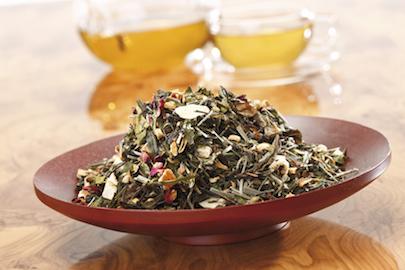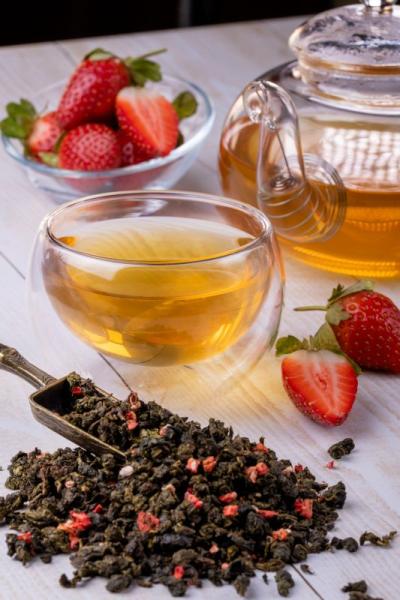Let's dissect a tea blend, say, "Strawberry Sunshine." The ingredients are black tea, freeze-dried strawberry pieces, natural flavor, and safflower petals. The visual appeal is immediate: bright red strawberry pieces promise an authentic berry taste, and delicate flower petals add elegance and color.
There's an industry secret that usually surprises people—those beautiful strawberry pieces contribute virtually nothing to the actual flavor you taste in your cup.
In our hypothetical fruit-flavored blend, the base tea might comprise 92% of the total weight, while those eye-catching strawberry pieces represent only 5%, natural flavoring accounts for 2%, and the decorative petals make up just 1%. The reality is that only the black tea base and the added flavoring create the strawberry taste experience. The tea acts as a flavor carrier, lending body and mouthfeel, while the fruit pieces and flower petals provide the crucial visual cues that help customers identify it as a strawberry-flavored blend.
This revelation opens the door to understanding the typical composition of a blended and flavored tea, where every ingredient serves a specific function in creating the perfect cup.
Flavor Carriers
The foundation of any successful flavored blend lies in selecting proper flavor carriers. These ingredients help distribute liquid flavoring when the tea is steeped. Camellia sinensis (true tea), apple pieces, and rooibos excel in this role because of how well they absorb moisture.
When working with powdered or encapsulated flavors, blenders need to be mindful of particle size differences. Like a bag of potato chips, smaller particles naturally settle, so it's necessary to work with similar particle sizes to ensure proper suspension and distribution.

Body and Mouthfeel
A thin, watery tea disappoints regardless of its flavor intensity. Professional blenders address this challenge by incorporating ingredients that contribute body and mouthfeel to the finished beverage. Hibiscus brings substantial thickness but introduces tartness that must be carefully balanced. Chicory root adds body with earthy undertones, while licorice root contributes both thickness and natural sweetness.
The art lies in selecting ingredients that enhance mouthfeel without overwhelming the primary flavor profile. A strawberry blend might benefit from a small percentage of hibiscus for body, but too much could shift the flavor away from pure strawberry.
The Five Basic Tastes
Every great tea blend requires careful attention to taste balance. Human tongues perceive five basic tastes: sweet, sour, salty, bitter, and umami. In tea blending, sweet, sour, and bitter dominate, though creative blends occasionally incorporate salty notes (think salted caramel) or umami elements.
Professional blenders use specific ingredients to adjust these taste components. Camellia sinensis provides controlled bitterness, while sweet blackberry leaf and licorice root add natural sweetness without artificial overtones. Hibiscus and apple pomace contribute tartness that can brighten fruit flavors or balance overly sweet profiles.
The key is understanding that different flavor profiles require different taste balances. A sour cherry blend should naturally emphasize tartness more than a sweet cherry variant, requiring the blender to adjust ingredient percentages accordingly.
Aromatic Complexity
Aroma significantly influences flavor perception, and skilled blenders leverage aromatic ingredients to enhance their creations. Spices and potent herbs excel in this role because they add fragrance complexity without drastically altering basic tastes or mouthfeel.

Consider a strawberry blend that tastes accurate but lacks the bright, fresh aroma associated with ripe berries.
Adding a small percentage of lemongrass introduces citrusy brightness that can enhance the strawberry perception without overwhelming the intended flavor. Ginger can add warmth and complexity, while mint provides cooling freshness.
The aromatic ingredient category offers perhaps the greatest creative potential aside from added flavoring, with hundreds of herbs, spices, and botanicals available to blend.
Visual Interest and Consumer Psychology
The visual component of tea blending is vital and operates on multiple levels.
First, the dry blend must look appealing in packaging, with colorful fruit pieces, interesting botanicals, and varied textures creating visual excitement. Second, the steeped tea color should match consumer expectations for the advertised flavor. So, the liquor color of a strawberry-flavored blend will probably lean reddish.
Many ingredients can alter liquor colors. Beetroot produces beautiful pink hues in small quantities, while butterfly pea flower creates dramatic blue colors that can shift to purple with pH changes. These ingredients may contribute minimal flavor but provide essential visual cues that enhance the overall tasting experience.
Visual interest also serves marketing purposes. Consumers expect to see strawberries in strawberry tea, regardless of their actual flavor contribution. Health-focused blends face similar expectations: valerian root in a sleepy-time blend may signal relaxation properties.
Economic Considerations
Every blend must balance quality and flavor aspirations with economic reality. Individual ingredient costs vary dramatically and change seasonally, making cost management a crucial blending skill. Flavoring is typically the most expensive component, often driving blenders to use minimal quantities while maximizing their impact through careful ingredient selection.
Professional suppliers work closely with customers to achieve target price points while maintaining quality standards. This collaboration often leads to creative solutions, such as using less expensive base ingredients to offset the cost of premium flavoring components.
Regional Preferences
Exceptional tea blends successfully balance all six ingredient functions while meeting their target market's specific flavor expectations and preferences. Regional taste differences significantly influence blend development, making market understanding crucial for commercial success.
Brands must either develop deep knowledge of their target markets' flavor preferences or provide clear guidance to their blending partners about desired flavor directions. This communication ensures that finished products resonate with local palates and cultural taste expectations. Professional suppliers rely on this market intelligence to create blends that perform well commercially rather than simply tasting good in isolation.
Understanding these market nuances transforms tea blending from simple ingredient mixing into sophisticated flavor architecture. Every visible piece, every aromatic note, and every taste sensation results from careful planning and precise execution by professionals who recognize that successful tea blending requires both technical expertise and marketing knowledge.
Plan to Attend or Participate in World Tea Expo, March 23-25, 2026
To learn about other key developments, trends, issues, hot topics and products within the global tea community, plan to attend World Tea Expo, March 23-25, 2026 in Las Vegas, co-located with Bar & Restaurant Expo. Visit WorldTeaExpo.com.
To book your sponsorship or exhibit space at World Tea Expo, or to inquire about advertising and sponsorship opportunities at World Tea News, contact:
Ellainy Karaboitis-Christopoulos, Business Development Manager, Questex
Phone: +1-212-895-8493; Email: [email protected]
Looking for professional tea education, certifications, and more? Visit World Tea Academy and register for courses today!
Also, be sure to stay connected with World Tea Expo on social media for details and insights about the event. Follow us on X, Facebook, Instagram and LinkedIn.
